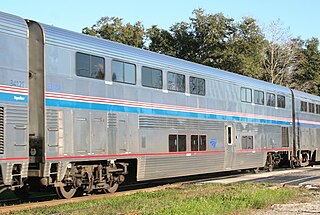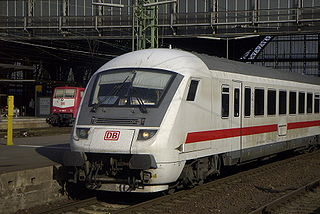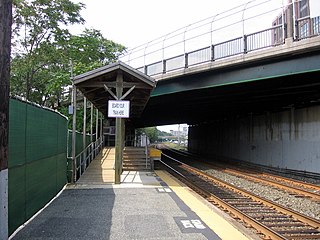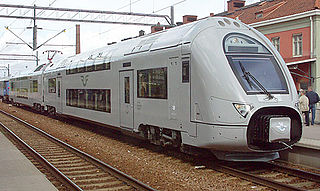
A railroad car, railcar, railway wagon, railway carriage, railway truck, railwagon, railcarriage or railtruck, also called a train car, train wagon, train carriage or train truck, is a vehicle used for the carrying of cargo or passengers on a rail transport network. Such cars, when coupled together and hauled by one or more locomotives, form a train. Alternatively, some passenger cars are self-propelled in which case they may be either single railcars or make up multiple units.

A bilevel car or double-decker coach is a type of rail car that has two levels of passenger accommodation as opposed to one, increasing passenger capacity.

A loading gauge is a diagram or physical structure that defines the maximum height and width dimensions in railway vehicles and their loads. Their purpose is to ensure that rail vehicles can pass safely through tunnels and under bridges, and keep clear of platforms, trackside buildings and structures. Classification systems vary between different countries, and loading gauges may vary across a network, even if the track gauge is uniform.

A passenger railroad car or passenger car, also called a passenger carriage, passenger coach, or passenger bogie is a railroad car that is designed to carry passengers. The term passenger car can also be associated with a sleeping car, a baggage car, a dining car, railway post office and prisoner transport cars.

The 4D was a prototype double deck electric multiple unit built for the Public Transport Corporation in Victoria, Australia, for operation on the Melbourne railway system. It remains the only double deck train to have ever operated in Melbourne. The train's name stood for "Double Deck Development and Demonstration."

The SR Class 4DD was an experimental double-decker electric multiple unit built in 1949 and operated by the Southern Railway until 1971. Conceived by Oliver Bulleid for the Southern Railway's commuter line from London Charing Cross to Dartford, the two trains were the only double-decker trains to be used on the mainline railway network in Britain. Whilst commonly used in continental Europe and North America, the restrictive railway loading gauge in the United Kingdom prohibits normal double-decker trains with two fully separated decks.

The BiLevel Coach is a bilevel passenger railcar currently built by Alstom and previously by Bombardier, Hawker Siddeley Canada, the Canadian Car and Foundry, and the UTDC. Used by North American commuter rail operators, they hold 360 passengers and feature a distinctive octagonal profile.

Transport in England includes road, rail, air, and water networks.

The TGV Duplex is a French high-speed train of the TGV family, manufactured by Alstom, and operated by the French national railway company SNCF. They were the first TGV trainsets to use bi-level passenger carriages with a seating capacity of 508 passengers, increasing capacity on busy high-speed lines. While the TGV Duplex started as a small component of the TGV fleet, it has become one of the system's workhorses.

A control car, cab car, control trailer, or driving trailer is a non-powered rail vehicle from which a train can be operated. As dedicated vehicles or regular passenger cars, they have one or two driver compartments with all the controls and gauges required to remotely operate the locomotive, including exterior locomotive equipment such as horns, bells, ploughs, and lights. They also have communications and safety systems such as GSM-R or European Train Control System (ETCS). Control cars enable push-pull operation when located on the end of a train opposite its locomotive by allowing the train to reverse direction at a terminus without moving the locomotive or turning the train around.

High Speed 2 (HS2) is a high-speed railway which is under construction in England. The line will run between Handsacre, in southern Staffordshire, and London, with a spur to Birmingham. HS2 is to be Britain's second purpose-built high-speed railway after High Speed 1, which connects London to the Channel Tunnel. London and Birmingham will be served directly by new high speed track, and services to Glasgow, Liverpool and Manchester will use a mix of new high speed track and the existing West Coast Main Line. The majority of the project is planned to be completed by 2033.

Railway platform height is the built height – above top of rail (ATR) – of passenger platforms at stations. A connected term is train floor height, which refers to the ATR height of the floor of rail vehicles. Worldwide, there are many, frequently incompatible, standards for platform heights and train floor heights. Where raised platforms are in use, train widths must also be compatible, in order to avoid both large gaps between platforms and trains and mechanical interference liable to cause equipment damage.

A passenger train is a train used to transport people along a railroad line. These trains may consist of unpowered passenger railroad cars hauled by one or more locomotives, or may be self-propelled; self propelled passenger trains are known as multiple units or railcars. Passenger trains stop at stations or depots, where passengers may board and disembark. In most cases, passenger trains operate on a fixed schedule and have priority over freight trains.

The X40 is a series of electric multiple units operated by SJ of Sweden. They are in service from Stockholm to Linköping, Västerås/Örebro, Uppsala and Gävle/Sandviken, and since 2010 to Gothenburg via Västerås. The double decker trains were built by Alstom from 2004–2008, with 43 units being delivered, either in a two-car or three-car configuration. It is based on the Coradia series, very similar to the French SNCF Class Z 26500 double decker trains, and similar to the X60-series.

The Stadler KISS is a family of bilevel electric multiple unit commuter trains developed and built since 2008 by Stadler Rail of Switzerland. As of 2016, 242 KISS trainsets comprising 1,145 cars have been sold to operators in eleven countries. Boarding is done into the lower deck.

Rail transport is an important mode of long-distance transportation in China. As of 2024, the country had more than 159,000 km (98,798 mi)[a] of railways, the second longest network in the world. By the end of 2023, China had more than 45,000 kilometres of high-speed rail (HSR), the longest HSR network in the world.

Double Decker Express are a series of trains started by Indian Railways for shorter routes in order to serve more people than a traditional chair car carriage.

Andreas Vogler Studio is an international and multidisciplinary firm for architecture and innovative design, with headquarters in Munich. The practice is led by its founder, Andreas Vogler and was established in 2014 shortly after he left Architecture and Vision. The practice specializes in novel solutions using technology, art, history and futurist ideas for inspiration.

The Regio 2N is family of a double-deck, dual-voltage electric multiple unit trainsets built for French rail operator SNCF to serve its regional rail routes.

The Caravaggio is an electric multiple unit (EMU) developed and built by Hitachi Rail Italy. It is named after the Italian Baroque painter Michelangelo Merisi da Caravaggio.





















